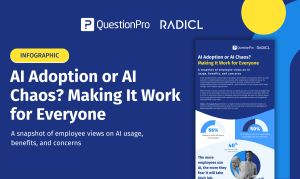
Most companies run surveys on their employees nowadays; even startups as small as ten run pulse polls and micro surveys. What started out as an already cumbersome process has only become increasingly sophisticated as companies, consultants, and tools try to “trick” employees to be ever-more honest and ever-more patient with increasingly long surveys.
Thankfully, most practices have settled on a happy medium of twenty-minute-long surveys, or at least spacing surveys over a longer period of time. Now you have your data—your glorious, hard-earned data. Now what?
It is only too easy to glance at the aggregate, company-wide average and accept the numbers as they are, especially if they are better than average. Look, I’m scoring an overall 4 out of 5, or a 3 out of 5 in employee satisfaction. My company is doing decent.
But do those numbers truly reflect the entire workforce? Do all 30, 300, or 3000 employees feel only so-so about their job satisfaction surveys. Or is it 15 people who feel great, and 15 people who feel particularly lousy? If so, what’s differentiating them? Supervisors? Business practices? Salary?
Management has already taken a big step in acknowledging that employee voices must be heard and regularly solicited. However, companies can’t rest on their laurels. After implementing a process of regularly surveying employees, the next obvious step should be to start parsing the data further. Find your weakest points and your highest points, not just company-wide, but by the team, department, even by supervisor. Surveys should point you in the right direction to ask the right questions; what are we doing different? What should we implement across teams? What practices should we put aside? Settling on aggregate and average data is a lost opportunity to improve your workforce’s engagement and job satisfaction.
Don’t let your bad apples spoil the entire barrel.
Have this problem? Diagnose your company with QuestionPro Workforce.







